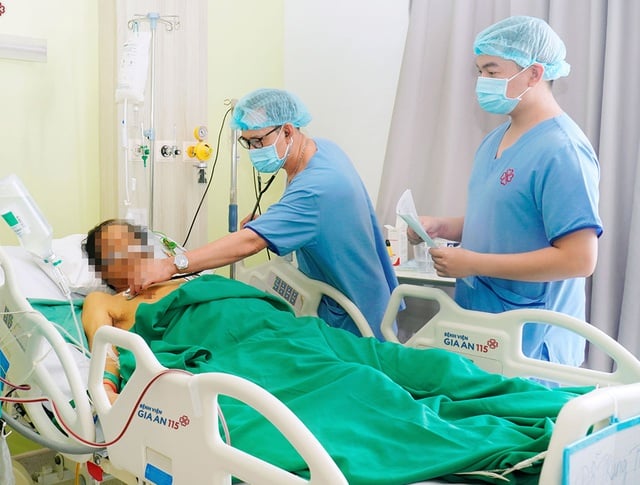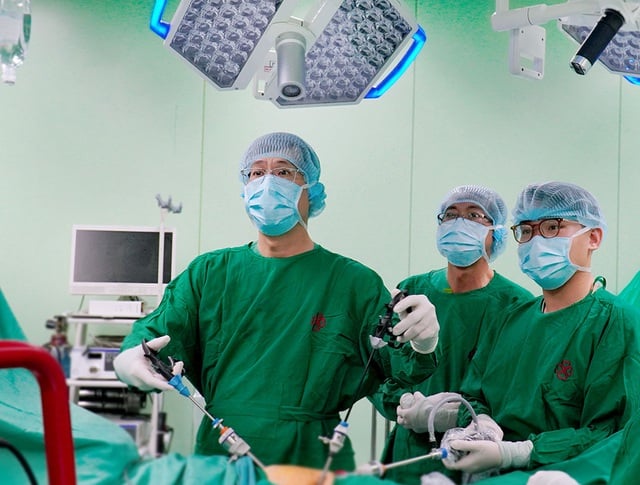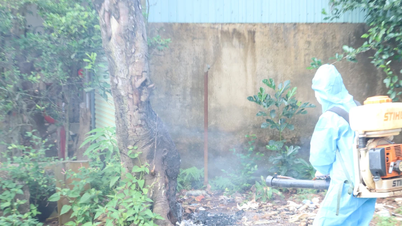After undergoing life-threatening intervention and more than a month of treatment in the Intensive Care Unit (ICU), he still steadfastly overcame the boundary between life and death, continuing his precious days with his family.
Biliary decompression intervention
Mr. D.TT, 63 years old, from Long Xuyen City, An Giang , came to Ho Chi Minh City for medical examination with jaundice, yellow eyes, and a weakened body. About 2 months ago, he was diagnosed with late-stage liver cancer. At this time, the liver tumor had spread, compressing the bile duct, causing bile duct obstruction, bile duct infection, severe liver failure, and ascites. His family took him to Gia An 115 Hospital for treatment.
Specialist 2 Doctor Tran Thanh Sang treats patients in ICU - Photo: KH
On April 10, Mr. T. was admitted to Gia An 115 Hospital for emergency treatment. There, the examination results showed multifocal liver cancer with metastasis to the hilar lymph nodes. A large tumor in the right liver invaded the portal vein, compressing the hepatic veins, inferior vena cava, compressing the hilum, compressing the bile duct, causing dilation of the remaining bile duct branches. The liver tumor invaded the bile duct causing biliary obstruction, biliary tract infection, and the total bilirubin index reached 402.84 µmol/L - more than 20 times the normal level. Blood tests also showed a severe blood clotting disorder.
This condition posed a major challenge, and doctors determined that if the biliary tract was not reopened in time, the patient would be unlikely to survive. However, the coagulation disorder needed to be treated first to avoid the risk of bleeding during the procedure. Over the course of three days, the anesthesia and resuscitation team coordinated plasma and platelet transfusions to improve the coagulation status, preparing for the crucial intervention.
On April 14, Mr. T. underwent endoscopic retrograde cholangiopancreatography (ERCP) to recanalize the bile duct. With the help of a C-arm, doctors discovered that the common bile duct and the intrahepatic bile duct were narrowed in 3 places. A metal stent (10x80 mm) was placed from the left hepatic duct - common hepatic duct through the common bile duct to restore bile flow. After successful stent placement, ultrasound examination showed that the bile duct in the 3rd segment was still dilated, so doctors had to continue performing percutaneous biliary drainage (PTBD) in the left liver.
More than a month of regaining every breath
But the challenge did not stop there. Due to late-stage liver cancer and a previous severe biliary tract infection, Mr. T. suffered from severe liver failure. The infection spread and led to septic shock, accompanied by renal failure and metabolic acidosis. He was immediately transferred to the Intensive Care Unit (ICU) and placed on continuous renal replacement therapy (CRRT) to support his liver and kidney function.
Doctors perform ERCP and PTDB to decompress the biliary tract for the patient - Photo: KH
Specialist 2 Doctor Tran Thanh Sang, Head of the Department of Intensive Care - Anti-Poison, said that the patient had liver failure, pre-hepatic coma, respiratory failure, severe cachexia, ascites, and then sepsis due to multiple strains of multidrug-resistant bacteria and pulmonary fungal infection. Doctors had to perform CRRT 3 times, adjust antibiotics based on the antibiotic susceptibility test, and use antifungal drugs to treat pulmonary fungal infection. Due to the severe cachexia, Mr. T. was fed through a gastric tube to provide the necessary energy and nutrients, helping the body to be strong enough to fight the disease. At the same time, because he had skin ulcers due to lying down for a long time, he received special care to treat and prevent the ulcers from progressing. Each day of treatment was a tireless effort. Doctors closely monitored every development, continuously coordinated to control the infection, nourish the body, and keep the patient's hope of survival.
"Despite falling into critical condition many times, the patient always cooperated with treatment and persistently followed every medical order. We saw in him a strong will to live and persevere to the end. His resilience and the wishes of his relatives inspired the entire medical team," Dr. Sang shared.
Thanks to the close coordination between the specialties, Mr. T.'s condition gradually stabilized. After more than a month of perseverance in the ICU, he was transferred to the Surgery Department for continued palliative care. On May 26, he was discharged from the hospital in a conscious state with stable vital signs, to the great joy of his family.
Dr. Sang said that liver cancer has a high mortality rate because it is often detected late. Early detection is the best way to increase the chance of treatment. Therefore, it is necessary to proactively screen periodically, especially in high-risk people such as those with chronic hepatitis and cirrhosis.
Source: https://thanhnien.vn/no-luc-gianh-su-song-cua-benh-nhan-ung-thu-gan-giai-doan-cuoi-185250604105204477.htm







![[Photo] Prime Minister Pham Minh Chinh attends the 80th anniversary of the founding of Voice of Vietnam Radio Station](https://vphoto.vietnam.vn/thumb/1200x675/vietnam/resource/IMAGE/2025/9/7/abdcaa3d5d7f471abbe3ab22e5a35ec9)


![[Photo] Impressive display booths of provinces and cities at the Exhibition 80 years of the Journey of Independence - Freedom - Happiness](https://vphoto.vietnam.vn/thumb/1200x675/vietnam/resource/IMAGE/2025/9/7/cd63e24d8ef7414dbf2194ab1af337ed)



















![[Photo] General Secretary To Lam attends the 55th anniversary of the first television program broadcast](https://vphoto.vietnam.vn/thumb/1200x675/vietnam/resource/IMAGE/2025/9/7/8b8bd4844b84459db41f6192ceb6dfdd)

















![[Highlight] VIMC's mark at the National Achievement Exhibition](https://vphoto.vietnam.vn/thumb/402x226/vietnam/resource/IMAGE/2025/9/7/932133a54d8b4becad48ef4f082f3eea)






![[COMING UP] Workshop: Resolving concerns for Business Households about eliminating lump-sum tax](https://vphoto.vietnam.vn/thumb/402x226/vietnam/resource/IMAGE/2025/9/7/5627bb2d0c3349f2bf26accd8ca6dbc2)







































Comment (0)